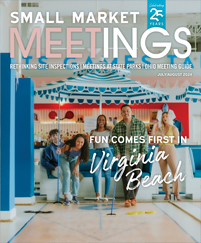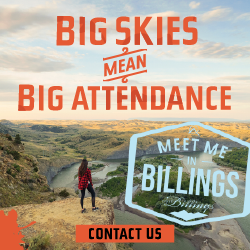
Courtesy Auburn-Opelika TB
Vincent Van Gogh seems a little miffed. In an Auburn student’s reworking of the artist’s famous self-portrait, the Dutch postimpressionist is wearing an Auburn University football uniform. Helmet in hand, the famous artist looks like anything but a sports fan in the framed portrait hanging on the wall above a happy throng at the popular Amsterdam Cafe in Auburn.
Such an unenthused Auburn Tigers supporter is hard to find in this town of about 60,000, where nearly everyone cheers for the home team. There’s good reason. The university’s approximately 25,000 undergraduate and graduate students, plus its roughly 8,000 employees, make a big impact economically and otherwise.
Most everything is tied to the university, and that includes meetings and conventions.
“Three-fourths of the time, the meetings that come here are directly associated with the university,” said the Auburn/Opelika Tourism Bureau’s Robyn Bridges. “Of the remaining 25 percent, about 20 percent of the time someone has a personal tie with the university.”
It’s no surprise, then, that Bridges and her peers at the tourist bureau have developed some ideas for off-site events that incorporate elements of Auburn University. Although few groups have made use of them in the past year or so, the ideas are easily implemented thanks to the tourist bureau’s connections at the university.
The list includes experiences found only at Auburn, activities that involve the school’s students, experts, facilities and traditions.
For example, who wouldn’t get a thrill by standing on the sidelines as the Auburn University Band marches sharply during practice. Or, for a different type of musical interlude, a performance by the AU Singers, a select group of vocalists who have performed around the country. Jordan-Hare Stadium, home of Tigers football, welcomes groups for tours or for receptions in the recently refurbished Lettermen’s Lounge, a comfortable, casual gathering place decked out in Auburn memorabilia.
Events can have an educational edge with expert speakers from Auburn’s Alabama Turfgrass Association, its world-renowned National Center for Asphalt Technology or the Southeastern Raptor Center (see sidebar, p. 12).
“We are just a small town. The resources of the university are what are unique to us and what we can offer to groups that meet here,” said Bridges. “Even if you’ve never heard of Auburn or seen a football game here, we can take you over to the Southeastern Raptor Center and have you six inches from a bald eagle. That is moving, no matter what school you cheer for.”
One of the prettiest campus facilities for an off-site venue is the Jule Collins Smith Museum of Fine Arts, opened in 2003 and surrounded by 15 acres of botanical gardens and a three-acre lake.
A terrace that overlooks the lake makes for relaxing dinners; even a standard auditorium is enlivened with a mural that depicts major events in the history of the town and the university.
Two hotels dominate
Despite the university, Auburn remains a small town, with two major convention properties: the Hotel at Auburn University and Dixon Conference Center, across from Auburn’s iconic Samford Hall, and the Auburn Marriott Opelika Hotel and Conference Center at Grand National, about 15 minutes from Auburn in Opelika, Auburn’s twin city.
The Hotel at Auburn University is not the traditional campus accommodation, which helped convince Tim Aylsworth to leave the Newport Beach, Calif., CVB and return to Alabama, where he grew up. He became the hotel’s director of sales and marketing last year.
“What I really found appealing about this hotel is the management group, West Paces Hotel Group, based out of Atlanta and led by Horst Schulze,” said Aylsworth. Schulze is known industrywide for his leadership at the Ritz-Carlton Hotel Co.
Schulze’s longstanding relationship with Auburn’s hospitality school is a big reason that “the first hotel West Paces took over was this hotel eight years ago,” said Aylsworth. Two years ago, $11 million was spent to renovate the hotel and conference center, which was opened by the university about 20 years ago.
“Seeing the photos of the hotel before the work, it came from a standard hotel to something much nicer,” said Aylsworth. “There is a casual elegance about it, but it is very comfortable.”
The 236-room hotel also keeps with its campus setting.
“We are considered the front door to Auburn University, and so when you walk in, you know exactly where you are walking into,” Aylsworth said.
Orange and blue, Auburn’s school colors, are used in abundance but not in a heavy-handed way. Oriental rugs in hues of blue and orange soften wood floors, pillows covered in a tiger-stripe print cushion melon leather couches, and bronze statues of eagles poised for flight perch on dark wood tables. The style is subtle and edgy, and many of the ideas are from the school’s interior design students. “It was a term project for the students, and we picked and chose the best ideas,” said Aylsworth.
Ties to the university go beyond decor. Hotel staff teach in Auburn’s hospitality program; the hotel also offers a practicum for hospitality majors and about 50 percent to 60 percent of its staff are students.
For meeting planners worried that the young staff might cause the hotel to skimp on service, Aylsworth offers this reassurance:
In an evaluation by an outside company that West Paces hires to measure its hotels’ performance, “the Hotel at Auburn ranks second in the company, behind a five-star resort,” he said.
The Dixon Conference Center is part of the hotel: 22,000 square feet of meeting space just off the hotel lobby. Two divisible ballrooms, one for groups as large as 400 persons, the other for functions for up to 150; a 356-seat auditorium; a seminar room; and two meeting rooms surround a circular prefunction foyer. Four small meeting rooms line a hallway leading into the center; three larger meeting rooms that can be used as one space for up to 100 people are down another hallway.
Today, the hotel’s business mix is half group, half transient. Aylsworth would like to extend its association business. “We have a fair share of Alabama state associations, but we would like to cross over and appeal to Georgia associations that are able to take their meetings out of state.”
Grand National gets golfers’ attention
The city’s other convention hotel, the Auburn Marriott Opelika Hotel and Conference Center at Grand National, is also noteworthy, tied to one of the most esteemed golf courses on Alabama’s Robert Trent Jones Golf Trail: Grand National.
The hotel followed the golf course by a decade, opening in 2002 as an independent property and converting to a Marriott three years later. The flag brought greater exposure, plus comfort, to meeting planners, who knew who they were dealing with, said Jay Prater, general manager.
At 129 guest rooms, the Auburn Marriott Opelika is one of the smallest of Marriott’s full-service properties, but its image is enhanced by Grand National, two 18-hole courses and an 18-hole par-3 course designed by Robert Trent Jones Sr.
The Marriott, with 15,000 square feet of meeting space, is surrounded by “1,000 acres of woods and 54 holes of golf,” said Prater.
National Village, a residential development that is part of the property, could bring more amenities to hotel guests down the road if developers decide to build a spa and a larger pool to serve owners of the some 1,200 homes planned for the village.
As would be expected, golf brings business to the Marriott.
“It is well known in the golfing community,” said Prater. “When we are presenting to an organization that’s thinking about having a meeting here, Grand National opens the door for us.”
At a property that is heavy on regional corporate meetings, about 60 percent of meetings incorporate golf.
Some groups meet for half a day and play golf the other half, taking the hotel shuttle or driving their own cars to the Grand National Clubhouse a few miles away, where a wraparound veranda is often used for gatherings and a meeting/banquet room is available. It and the course were built in the early 1990s.
“Grand National was one of the original golf courses of the Robert Trent Jones Trail, built when Mr. Jones Senior was still alive. He was very involved in the design of the course,” said Prater.
Apparently, the 650-acre lake and rolling lands around it were special to the revered course designer.
After Jones saw the land from a helicopter, he called it the greatest site he’d seen for a golf course, “high praise from the No. 1 golf designer that ever lived,” said Prater.
Golf in Auburn-Opelika gets high praise in general.
“Grand National is obviously the blue ribbon, but the city of Auburn has some great public courses that are recognized nationally,” said Bridges. “Our goal when groups come in is for them to play Moore’s Mill or the Auburn University Club, too.”
Those courses are private clubs, but because of the tourist bureau’s relationship with local courses, it can help groups make arrangements to play on most of them.
Such congeniality pays off for meeting planners, and it extends to the university, which does all it can to help the tourism bureau give meetings the Tiger touch.
“There is nothing that we have asked that they haven’t bent over backward to help us,” said Bridges.
For more on Auburn Meetings:
Tigers have this town by the tail
The eagles have landed
A quick look at Auburn-Opelika











